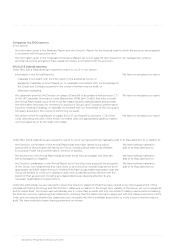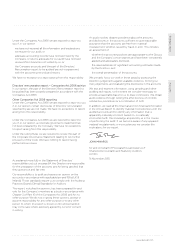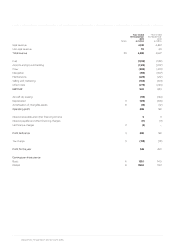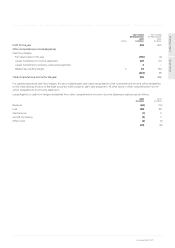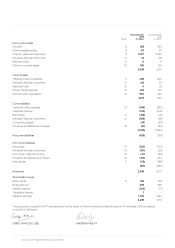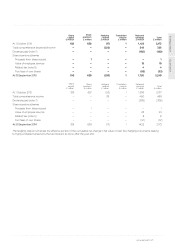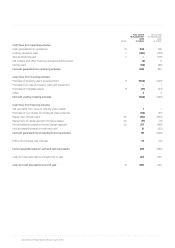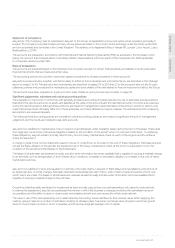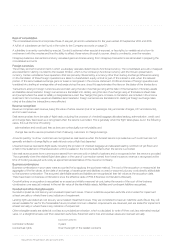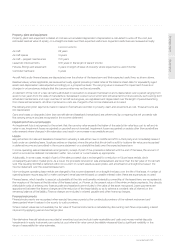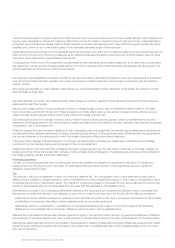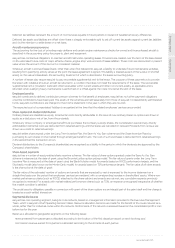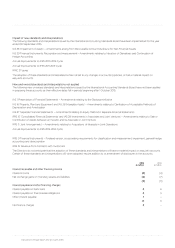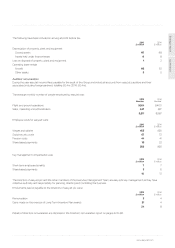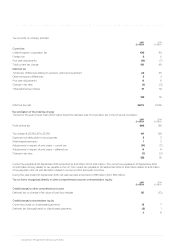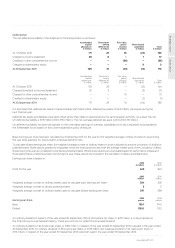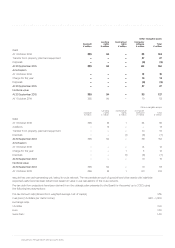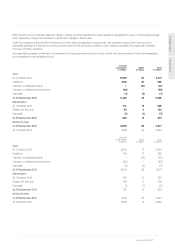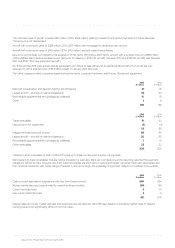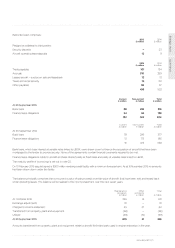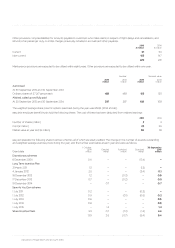EasyJet 2015 Annual Report Download - page 102
Download and view the complete annual report
Please find page 102 of the 2015 EasyJet annual report below. You can navigate through the pages in the report by either clicking on the pages listed below, or by using the keyword search tool below to find specific information within the annual report.
98 easyJet plc Annual report and accounts 2015
Notes to the accounts continued
1. Significant accounting policies continued
Cash and cash equivalents comprise cash held in bank accounts with no access restrictions and money market deposits, bank deposits and
tri-party repos repayable on demand or maturing within three months of inception. Interest income on cash and money market deposits is
recognised using the effective interest method. Restricted cash comprises cash deposits which have restrictions governing their use and is
classified as a current or non-current asset based on the estimated remaining length of the restriction.
Impairment losses are recognised on financial assets carried at amortised cost where there is objective evidence that an impairment loss has
been incurred. The amount of the loss is measured as the difference between the asset’s carrying amount and the present value of future
cash flows, discounted at the original effective interest rate.
If, subsequently, the amount of the impairment loss decreases, and the decrease can be related objectively to an event that occurred after
the impairment was recognised, the appropriate portion of the loss is reversed. Both impairment losses and reversals are recognised in the
income statement as components of net finance charges.
Non-derivative financial liabilities
Non-derivative financial liabilities are initially recorded at fair value less directly attributable transaction costs, and subsequently at amortised
cost, and include trade and other payables, borrowings and provisions. Interest expense on borrowings is recognised using the effective
interest method.
Borrowings are classified as current liabilities unless there is an unconditional right to defer settlement of the liability for at least 12 months
after the balance sheet date.
Derivative financial instruments and cash flow hedging
Derivative financial instruments are measured at fair value. Hedge accounting is applied to those derivative financial instruments that are
designated as cash flow hedges.
easyJet uses foreign currency forward exchange contracts to hedge foreign currency risks on transactions denominated in US dollars,
Euros, Swiss francs and South African rand. These transactions primarily affect revenue, fuel, aircraft dry leasing costs, and the carrying
value of owned aircraft. easyJet uses jet fuel forward contracts to hedge fuel price risks.
Gains and losses arising from changes in the fair value of these forward contracts are recognised in other comprehensive income and
deferred in the hedging reserve to the extent that the hedges are determined to be effective. All other changes in fair value are recognised
immediately in the income statement.
When the hedged forecast transaction relates to an item of property, plant and equipment, the relevant accumulated gains and losses are
transferred from the hedging reserve and included in the initial carrying amount of that purchased asset. Otherwise they are recognised in
the income statement in the same period in which the hedged transaction affects the income statement.
In the event that a hedged forecast transaction is no longer considered highly probable, any related gains and losses are immediately
transferred from the hedging reserve and recognised in the income statement.
Hedge accounting is discontinued when a hedging instrument is derecognised (e.g. through expiry or disposal), or no longer qualifies for
hedge accounting. Where the hedged item remains a highly probable forecast transaction, the related gains and losses remain deferred in
the hedging reserve until the transaction takes place.
Financial guarantees
If a claim on a financial guarantee given to a third party becomes probable, the obligation is recognised at fair value. For subsequent
measurement, the carrying amount is the higher of initial measurement and best estimate of the expenditure required to settle the
obligation at the reporting date.
Tax
Tax expense in the income statement consists of current and deferred tax. Tax is recognised in the income statement except when it
relates to items credited or charged directly to other comprehensive income or shareholders’ equity, in which case it is recognised in other
comprehensive income or shareholders’ equity. The charge for current tax is based on the results for the year as adjusted for income that
is exempt and expenses that are not deductible using tax rates that are applicable to the taxable income.
Deferred tax is provided in full on temporary differences relating to the carrying amount of assets and liabilities, where it is probable that
the recovery or settlement will result in an obligation to pay more, or a right to pay less, tax in the future, with the following exceptions:
where the temporary difference arises from goodwill or from the initial recognition (other than in a business combination) of other assets
and liabilities in a transaction that affects neither taxable income nor accounting profit; and
deferred tax arising on investments in subsidiaries is not recognised where easyJet is able to control the reversal of the temporary
difference and it is probable that the temporary difference will not reverse in the foreseeable future.
Deferred tax is calculated at the tax rates that are expected to apply in the periods in which recovery of assets and settlement of liabilities
are expected to take place, based on tax rates or laws enacted or substantively enacted at the date of the statement of financial position.
Deferred tax assets represent amounts recoverable in future periods in respect of deductible temporary differences, losses and tax credits
carried forwards. Deferred tax assets are recognised to the extent that it is probable that there will be suitable taxable profits from which
they can be deducted.


